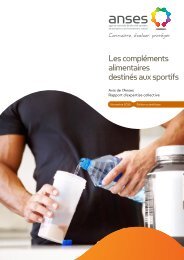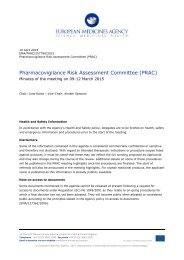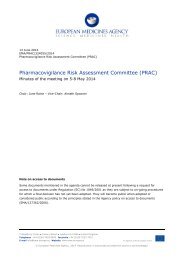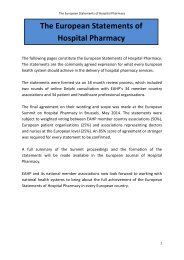WC500165698
WC500165698
WC500165698
Create successful ePaper yourself
Turn your PDF publications into a flip-book with our unique Google optimized e-Paper software.
Summary of advice<br />
The PRAC acknowledged that regarding the cancer signal, 3 reviews of mechanistic studies, one metaanalysis<br />
of randomized trials and observational studies, 3 clinical trials and 8 observational studies had<br />
been conducted. For insulin glargine in particular, publications of 2 non-clinical studies, one clinical trial<br />
and 7 observational studies were assessed. Regarding the signal of cardiovascular morbidity, a series<br />
of papers retrieved following a literature search were reviewed. Overall, 7 mechanistic studies, 11<br />
randomized trials, 2 meta-analyses of randomized trials and 22 observational studies were assessed.<br />
In addition to assessing these publications, the MHRA performed a Drug Utilisation Study using the<br />
Clinical Practice Research Datalink to examine how insulin is being used to treat type 2 diabetes in the<br />
UK, and compared this with recommendations for use of insulin described in national clinical guidance.<br />
The PRAC stressed that the cancer risk associated with insulin use in the treatment of type 2 diabetes<br />
is the focus of highly-active and fast-moving research. Nonetheless, the currently available studies of<br />
relevance have too many methodological limitations to allow a conclusion to be reached on causality.<br />
From the assessment of cardiovascular morbidity, although there is currently very little evidence that<br />
use of insulin in type 2 diabetes leads to a reduction in MACE, there is also no consistent evidence of<br />
cardiovascular harm from use of insulin in patients with type 2 diabetes, while acknowledging some<br />
exceptions (ACCORD trial).<br />
Overall, no regulatory action is considered necessary. The PRAC considered that at this stage, given<br />
the limitations of the evidence currently available and in anticipation of the study results that will<br />
become available from a range of studies, no revisions are required to the RMPs for insulin-containing<br />
products.<br />
12. Organisational, regulatory and methodological matters<br />
12.1. Mandate and organisation of the PRAC<br />
12.1.1. PRAC Rules of Procedure<br />
<br />
Revision of the Rules of Procedure<br />
The PRAC adopted a revised version of the rules of procedure following incorporation of Regulation<br />
(EU) 1235/2010 and Directive 2010/84/EU into the Agreement on the European Economic Area (“the<br />
EEA Agreement”). The PRAC Rules of Procedure have been amended to be in line with other EMA<br />
Scientific Committees to reflect the involvement of Members nominated by the EEA-EFTA countries in<br />
the PRAC. They will be published after receiving a favourable opinion from the Commission and the<br />
EMA Management Board.<br />
Post meeting note: the revised Rules of Procedure received a favourable opinion from the EMA<br />
Management Board at its 20 March 2014 meeting and by the EC on 9 April 2014 and will be published<br />
on the EMA website.<br />
12.2. Pharmacovigilance audits and inspections<br />
12.2.1. Pharmacovigilance Inspections<br />
12.2.1.1. Union Procedure on Follow-up to Pharmacovigilance Inspections<br />
<br />
<br />
Union procedure on the coordination of EU pharmacovigilance inspections<br />
Union procedure on sharing of pharmacovigilance inspection information<br />
Pharmacovigilance Risk Assessment Committee (PRAC)<br />
EMA/PRAC/253432/2014 Page 38/64








